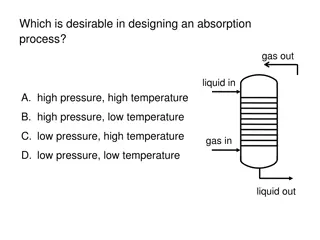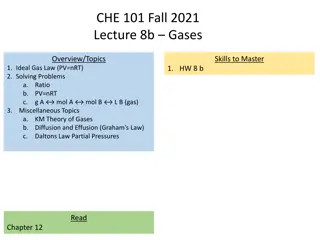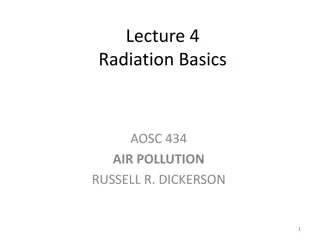Gas Absorption and Atmospheric Soundings: Principles and Applications
Gases in the atmosphere absorb radiation through various mechanisms such as changing rotational/vibrational energy and exciting electrons. This absorption plays a crucial role in remote sensing applications. The absorption principles differ for molecules like CO2 and H2O, influencing their vibrational modes. Understanding these mechanisms is vital for analyzing infrared emission spectra observed from space and interpreting major absorption bands in atmospheric soundings.
Download Presentation

Please find below an Image/Link to download the presentation.
The content on the website is provided AS IS for your information and personal use only. It may not be sold, licensed, or shared on other websites without obtaining consent from the author. Download presentation by click this link. If you encounter any issues during the download, it is possible that the publisher has removed the file from their server.
E N D
Presentation Transcript
Weighting Functions and Atmospheric Soundings, Part II: Gas absorption Ralf Bennartz Cooperative Institute for Meteorological Satellite Studies University of Wisconsin Madison Figure from http://www.lsbu.ac.uk/water/images/v1.gif
Outline Why do gases absorb radiation? Where do gases absorb radiation? Relevance to remote sensing Recap: What is important?
Absorption principles Absorption of photons can change rotational/vibrational energy of molecules (infrared/microwave). Absorption can also excite electrons into different orbits (near-infrared). Absorption can also disrupt molecules (e.g. Ozone absorption in UV) First three effects are quantized, i.e. they only occur at specific wavelengths dependent on molecule
Absorption principles Absorption of photons can change rotational/vibrational energy of molecules (infrared/microwave). Absorption can also excite electrons into different orbits (near-infrared). Absorption can also disrupt molecules (e.g. Ozone absorption in UV) First three effects are quantized, i.e. they only occur at specific wavelengths dependent on molecule
Absorption principles Different molecules vibrate differently depending on their shape 667 cm-1 1366 cm-1 2349 cm-1 The two major absorbers in the atmosphere are CO2 and H2O. 1595 cm-1 3562 cm-1 3756 cm-1 The three different vibrational modes of these gases are shown below Figure from Petty (2006)
Absorption in the infrared O H2O Vib. H2O Rot. 3 CO2 Emission spectrum observed from space over the tropical Pacific Figure from Petty (2006)
Absorption in the infrared Figure from Petty (2006)
Absorption in the infrared Wavelength [mm] Where were those spectra taken? 30 25 20 18 15 14 13 12 11 10 9 8 160 140 Nauru (Tropical Western Pacific) 11/15/98 300 K 120 Was the instrument looking up or down? Radiance [mW / m2 sr cm-1] 100 Barrow, Alaska 3/10/99 80 60 Identify the major absorption bands! 245 K 40 20 0 300 400 500 600 700 800 900 1000 1100 1200 1300 1400 Wavenumber [cm-1] Figure from Petty (2006)
Recap Different processes lead to absorption in the atmosphere. In the infrared vibrational bands dominate at shorter wavelength, at longer wavelength rotational bands. There are 100s of thousands of absorption lines for different isotope, combinations of rotational/vibrational modes, harmonics etc . CO2 and H2O bands are particularly important in temperature/moisture profiling Other gases, such as CH4, CO, O3 also have minor absorption bands in the infrared.























